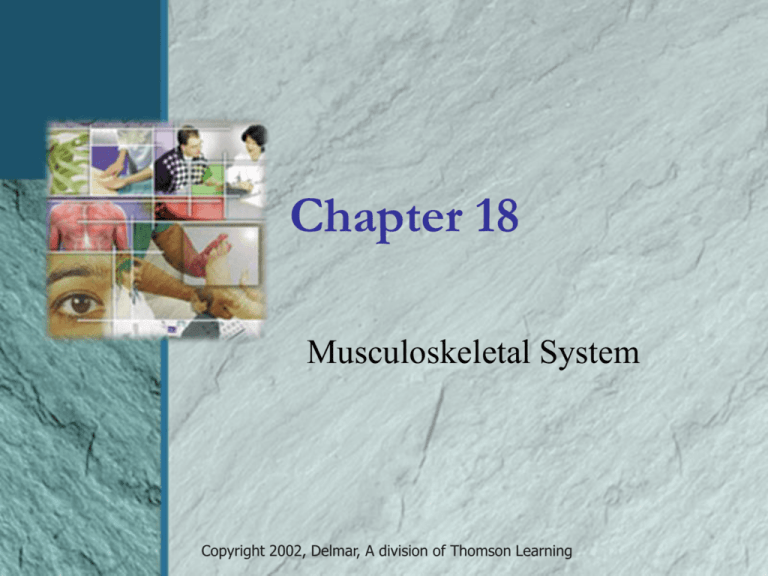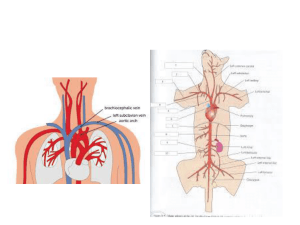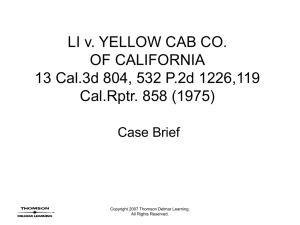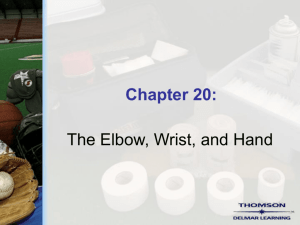Chapter 18 - Delmar
advertisement

Chapter 18 Musculoskeletal System Copyright 2002, Delmar, A division of Thomson Learning Competencies Elicit a health history from a patient with a musculoskeletal chief complaint. Perform inspection and palpation of the musculoskeletal system. Describe the range of motion movements of the major joints. (continues) Copyright 2002, Delmar, A division of Thomson Learning Competencies Measure range of joint motion with a goniometer. Assess muscle strength of the arms and legs using the muscle strength grading scale. Document the findings of the musculoskeletal assessment. Copyright 2002, Delmar, A division of Thomson Learning Anatomy and Physiology Bones 206 bones Axial skeleton Appendicular skeleton Structure Diaphysis Epiphysis Periosteum Medullary cavity (continues) Copyright 2002, Delmar, A division of Thomson Learning Anatomy and Physiology Muscles 600 muscles Types Cardiac Smooth Skeletal Involuntary vs. Voluntary Tendons Attach muscle to bone (continues) Copyright 2002, Delmar, A division of Thomson Learning Anatomy and Physiology Ligaments Connect bone to bone at the joint level Bursae Fluid-filled sacs (continues) Copyright 2002, Delmar, A division of Thomson Learning Anatomy and Physiology Joints Union between two bones Permit some movement of bones Types Synarthroses Ampliarthroses Diarthroses (synovial) (continues) Copyright 2002, Delmar, A division of Thomson Learning Anatomy and Physiology Types of joints Condyloid Hinge Saddle Ball and socket Gliding Copyright 2002, Delmar, A division of Thomson Learning Descriptive Terms for Joint ROM Flexion Extension Hyperextension Adduction Abduction Internal rotation (continues) Copyright 2002, Delmar, A division of Thomson Learning Descriptive Terms for Joint ROM External rotation Circumduction Supination Pronation Opposition Eversion Inversion (continues) Copyright 2002, Delmar, A division of Thomson Learning Descriptive Terms for Joint ROM Dorsiflexion Plantar flexion Elevation Depression Protraction Retraction Gliding Copyright 2002, Delmar, A division of Thomson Learning Health History: Patient Profile Age Gender Early adult Mid to late adult Female Male Race Caucasian African American Copyright 2002, Delmar, A division of Thomson Learning Common Chief Complaints Pain Weakness Limited movement Stiffness Deformity Copyright 2002, Delmar, A division of Thomson Learning Characteristics of Chief Complaint Location Quantity Quality Associated manifestations Aggravating factors Alleviating factors Setting Timing Copyright 2002, Delmar, A division of Thomson Learning Medical History Musculoskeletal specific Joint disorders Bone or skeletal disorders Neuromuscular disorders Nonmusculoskeletal specific Infections Blood disorders Peripheral vascular disorders Copyright 2002, Delmar, A division of Thomson Learning Surgical History Arthroscopy Arthroplasty Diskectomy or Laminectomy Internal fixation External fixation Amputation Reattachment of a limb Copyright 2002, Delmar, A division of Thomson Learning Health History Common medications Anti-inflammatory agents Analgesics: narcotic or non-narcotic Muscle relaxants Steroids Calcium supplements Communicable diseases (continues) Copyright 2002, Delmar, A division of Thomson Learning Health History Injuries/accidents Special needs Amputation Use of assistive devices Hemiplegia, quadriplegia, paraplegia Childhood illnesses Polio Juvenile arthritis (continues) Copyright 2002, Delmar, A division of Thomson Learning Health History Family history Rheumatoid arthritis Paget’s disease Osteoporosis Social history Alcohol or tobacco use Work environment: role of repetitious movements Home environment: physical layout/barriers (continues) Copyright 2002, Delmar, A division of Thomson Learning Health History Hobbies/leisure activities Contact activities Weight-bearing activities Nonweight-bearing activities (continues) Copyright 2002, Delmar, A division of Thomson Learning Health History Health maintenance activities Sleep Diet Exercise Intake of calcium, nutritional supplements Weight-bearing, nonweight-bearing, aerobic Use of safety devices Health checkups Copyright 2002, Delmar, A division of Thomson Learning Safety Tips to Decrease Fall Risk Avoid the following Scatter or throw rugs Slick floors Dim lighting Clutter Cords on the floor Ill-fitting shoes Stairways without banisters Copyright 2002, Delmar, A division of Thomson Learning Assessment Equipment Goniometer Tape measure and felt tip marker Sphygmomanometer General approach Patient comfort Compare nonaffected to affected Proceed in cephalocaudal order Copyright 2002, Delmar, A division of Thomson Learning General Assessment Overall appearance Posture Gait and mobility Weight-bearing status Gait patterns Transfer ability (continues) Copyright 2002, Delmar, A division of Thomson Learning General Assessment Normal findings Height and weight are proportionate Full ROM Ambulate independently No structural defects Shoulders and hips are level Head and torso are upright Stable gait Copyright 2002, Delmar, A division of Thomson Learning Inspection Muscle size and shape Hypertrophy Atrophy Involuntary muscle movements Limb circumference Joint contour and periarticular tissue (continues) Copyright 2002, Delmar, A division of Thomson Learning Inspection Normal findings Symmetrical muscle contour No involuntary muscle movements Bilateral limb circumference is within 1–3 cm of each other Joints are flat when extended, and smooth/rounded during flexion No joint enlargement or deformity Copyright 2002, Delmar, A division of Thomson Learning Palpation Muscle tone Joints Special techniques Range of motion Measure Movement against resistance or gravity Goniometer Muscle strength Scale Copyright 2002, Delmar, A division of Thomson Learning Special Techniques for Assessing Joints Temporomandibular Cervical spine Shoulders Elbows Wrist and hands Knees Ankles and feet Spine Copyright 2002, Delmar, A division of Thomson Learning Special Assessments Chvostek’s sign Drop arm test Trousseau’s sign Grip strength Tinel’s sign Phalen’s sign (continues) Copyright 2002, Delmar, A division of Thomson Learning Special Assessments Tredelenburg test Measuring limb length Patrick’s test Bulge sign Patellar ballottement Apley’s sign (continues) Copyright 2002, Delmar, A division of Thomson Learning Special Assessments McMurray’s sign Drawer test Lachman’s test Varus stress test Valgum stress test Thompson test Milgram test Copyright 2002, Delmar, A division of Thomson Learning Use of Assistive Devices Crutches Cane Walker Brace, splint, immobilizer Cast Copyright 2002, Delmar, A division of Thomson Learning Normal Findings Normal muscle tone No crepitus or masses Joints without pain, tenderness, or swelling Full ROM Normal muscle strength Muscle strength is equal bilaterally No lordosis, kyphosis, or scoliosis Copyright 2002, Delmar, A division of Thomson Learning Gerontological Variations Bone density decreases Weaker bones, increased risk for osteoporosis Muscle atrophy Decreased muscle strength Deterioration of articulating cartilage Vertebral inflexibility Thoracic kyphosis Copyright 2002, Delmar, A division of Thomson Learning







